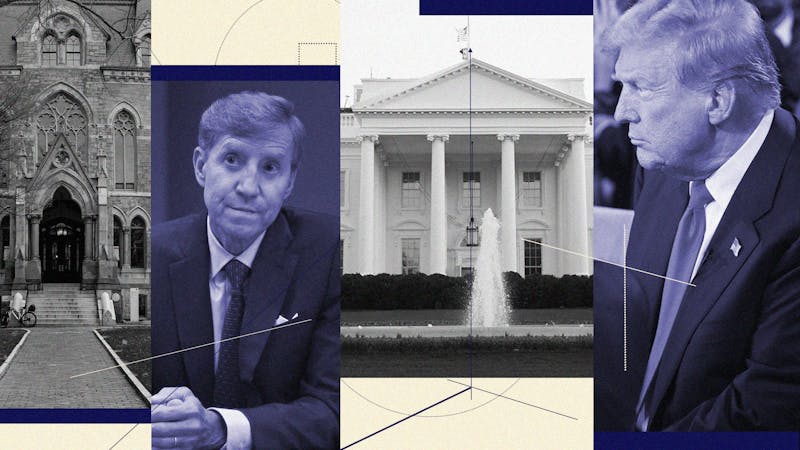
"Bring in the robot!"
But it's not quite as easy as Dr. Joseph Woo, professor of surgery and director of the Minimally Invasive and Robotic Cardiac Surgery Program, makes it sound.
The narrow, beige machine with three black "arms" jutting out of its side is over six feet tall, and it takes Woo's team -- approximately eight people, including nurses, physician assistants and doctors, all clad in sterile turquoise blue scrubs, masks, booties and gloves -- nearly 10 minutes just to set everything up.
After all, the da Vinci Surgical System is a complicated machine. Its projections stick out like human arms, with hinges that allow for perfect bending with almost 360 degrees of rotation. One arm is tipped with cameras that create a 3-D image in a console 10 feet away from the patient. The other two arms are fully "articulated," allowing for almost the same movement as a surgeon's wrist, but without the possibility of tremor.
The robot is capable of holding scalpels, scissors, clamps, pincers and other common surgical tools on a micro-sized level, not more than several millimeters in dimension.
Once the robot is prepared and Woo takes the helm at the console, the two are ready to do what they do best -- cardiac surgery.
•
For Woo, however, the operation begins about three hours earlier, when he personally makes the first, three-inch incision in his patient.
The operating room staff has been prepping the man even longer -- since 5 a.m.
For more than four hours, the operating room has been abuzz with activity as each professional specialist methodically prepares the equipment and the patient for a full day of intense cardiothoracic surgery. By now, the efforts of the team are perfectly synchronized.
When Woo enters at around 9:30 a.m, white fluorescent lights illuminate the patient -- asleep by anesthesia -- who is expecting to wake up the healthy, energetic man that he had once been.
Up until recently, the 37-year-old man had played tennis three hours every day. But then he began experiencing shortness of breath with minimal exertion, just by climbing a flight of stairs, and soon after, he was diagnosed with severe mitral valve prolapse -- a condition in which a valve in his heart that normally prevents backflow of blood malfunctions and no longer creates a tight seal between the chambers of the heart. As a result, his heart has to work harder to pump his blood, and it's taking a toll on his body.
This is why he came to Woo in the first place -- to fix the leaky mitral valve.
Woo makes the first incision himself. Unaided by the robot, the scalpel in his hands cut a relatively small incision into the upper left region of the patient's chest.
This minimally invasive approach for a major operation represents the advantage of robotic cardiac surgery.
Normally, cardiac surgery involves breaking through the sternum and opening the entire chest cavity. However, the da Vinci robotic system enables the doctor to perform a minimally invasive procedure -- only a three-inch incision is necessary -- that does not break any bones of the sternum or rib cage. The patient's recovery time is therefore significantly less, and he can go home one to two days earlier on average.
"Post-operative, two to three weeks later, they look great," Woo explains.
•
Now, the patient is in and out in just three days. But this hasn't always been the case.
The Robotic Cardiac Surgery Program at the Hospital of the University of Pennsylvania was founded less than a year ago. As a result, HUP is one of only 12 hospitals in the nation with the proper equipment and surgeons qualified to use the da Vinci machine in the operating room.
Metaphorically speaking, HUP is the Mesopotamia of robotic cardiac surgery -- having been one of the first medical centers in the country chosen to perform intracardiac robotic surgery, just approved by the FDA in November 2002.
"The concept of robotic surgery was first envisioned by the military, and the early funding for research was provided by the Department of Defense in the late '80s and early '90s," Woo explains. "The original idea was to a have a mobile armored operation unit that had a surgical robot in it, which would roam the battlefield and have the capability to remotely hook up with an aircraft carrier, allowing a surgeon to operate on the wounded soldier from miles away."
While battlefield soldiers have yet to benefit from robotic surgery, patients at HUP are benefiting right now.
"Eventually, the technology evolved into a more commercial medical pursuit," Woo says.
With safety assured, the robot has been approved for use in other surgeries, including, "relatively easy" gall bladder operations and other abdomen and cardiac operations.
But despite the many procedures to its name, the robot can't do it all itself -- Woo is one of only a dozen surgeons specifically trained to operate the robot.
At the age of 36, Woo is confident, moving on the cutting edge of his field. And why shouldn't he be? The slim surgeon is bright -- with the ability to also do triple integrals in his head.
He's mild-mannered and relaxed, but more importantly, he's able to remain eerily focused and calm while performing innovative cardiac surgery.
"Our hospital, particularly our departmental leadership, has always been interested in being at the cutting edge of technology and being a leader in medical care," Woo says, explaining how he decided to get involved in robotics.
Despite the risk involved in any surgery, Woo explains that when trying something for the first time -- like robotic cardiac surgery -- fear is not part of his job.
"We don't really have fears," he says matter-of-factly. "More like deep concerns about the well-being and safety of our patients."
•
Back in the operating room, bright lights illuminate the patient's chest, and blue sheets drape over benches and equipment, indicating the realm of sterility. Clear cabinets, housing everything from saline solution to scalpels to morphine, stand in front of the white walls, as bypass machines, EKG machines, six digital and analog monitors and TV screens fill the room.
A constant suctioning sound of blood being vacuumed from the hole in the patient's chest disrupts the silence.
But preconceived notions about surgery disappear here -- blood does not ooze and squirt from the red incision, and the room is practically odorless.
Walking over to the other side of the operating room, Woo positions himself in the console. For the next hour, he uses his thumb and forefinger to manipulate the robot's grasping "fingers," while viewing the surgical operating field on a 3-D video screen. Another cardiac surgeon positions himself next to the patient to aid with any complications.
The robot moves seamlessly in response to Woo's manipulations. It is able to get three "arms" into a hole that would barely even fit one human hand, let alone perform surgery.
Watching the procedure -- with Woo physically removed from the operating table -- it appears as though the robot is operating all by itself, its arms bending and moving, as if with a brain of its own.
"Here's our problem," Woo remarks suddenly.
A piece of beige-colored cartilaginous material appears on the mostly red video screen as Woo explains, "This is the prolapsed material."
Using his fingers, Woo dictates where the robot is to make the cuts, and after 10 minutes, the assisting surgeon pulls out the diseased valve. Woo then inserts a new valve, and the problem -- at least theoretically -- is fixed.
The full success of the operation will not be known until after months of post-operative check-ups.
Things, however, are promising, and according to Woo, "There were no complications."
•
Woo has over 1,000 surgeries under his belt, in addition to television appearances and published papers -- research is another one of his specialties. Now, he can add upwards of 40 da Vinci robotic surgeries to the list.
But Woo doesn't linger on his plentiful achievements. His main concern is for improving the health of his patients, and he is willing to use all advancements -- robotics included -- to help him achieve this goal.
The most important factor with the da Vinci system is that "many patients are benefiting from this technology," Woo says. "With the refinement of equipment and techniques, the potential for healing and helping patients will hopefully increase."
But the potential improvements that may occur as technology and medicine continue to overlap seem to have clear signs for the future -- robots and the doctors who guide them may become our next best friends and invited into our hearts.
The Daily Pennsylvanian is an independent, student-run newspaper. Please consider making a donation to support the coverage that shapes the University. Your generosity ensures a future of strong journalism at Penn.
DonatePlease note All comments are eligible for publication in The Daily Pennsylvanian.







